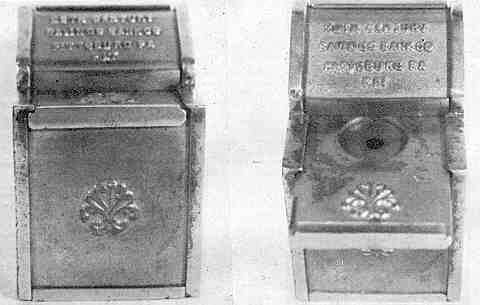20th Century Savings Bank
by F.H. Griffith - HOBBIES Magazine - January, 1973

Where mechanical bank collectors are concerned what could be more appropriate for the initial 1973 issue of HOBBIES than the announcement of a new find in a quite interesting mechanical bank. Certainly the 20th Century Savings Bank has not generally been known to exist, and as a matter of fact it was unknown to the writer until rather recently.
In any case, this bank was, for some years, more or less under wraps. It finally has come to light so we presently can list it as No. 216 in the numerical classification.
The slanted top of the bank has the following wording cast thereon: ‘20th Century Savings Bank Co. Pittsburg, Pa. Pat’. Needless to say, the Pittsburgh background has particular appeal to the writer and the spelling of the name Pittsburg, omitting the ‘h’, has particular significance.
In 1890 the U.S. Board on Geographic Names eliminated the ‘h’ from all cities and towns having names ending in ‘burgh’. This did not sit too well with the city of Pittsburgh and a Citizen’s Protest Board in 1911 finally accomplished a reversal of the decision and the ‘h’ was restored to Pittsburgh.
Although the name 20th Century definitely would indicate just before or right after 1900, the fact the ‘h’ is omitted from Pittsburgh on the bank very definitely establishes the time period of the bank. It necessarily was made during the 21 year period involved, but most likely around the 1900 time.
As to the manufacturer of the bank, we have run into a dead end. There are absolutely no records of a 20th Century Savings Bank Company ever having been in Pittsburgh.
Possibly some company under another name made the bank, but we have had no luck in this direction either. The writer has not given up as yet on this research, but he certainly has reached a standstill at this point.
The bank shown is in very good original condition. It is cast-iron with a washed or lightly nickel-plated finish. Raised relief-type decorations are on the front and the top sliding drawer. Each side has more elaborate decorations thereon.
The bank is pictured in Figure 1 either before or after operation. Figure 2 pictures the bank with the sliding drawer pulled out ready to receive the coin which is placed in the round recessed section. When the drawer is pushed in the coin is deposited in the bank.
The coin goes into a tapered chute inside the bank and on into the lower section. Each side of the sliding plate or drawer has geared teeth and there is a movable pin on each side which fits into these teeth.
When the bank is turned upside down the pins fall into place in various positions of the drawer, including open or closed position, causing the drawer to be locked in place in any of the positions. Working in this fashion, no coins can be removed or shaken from the bank. Also no coins can be removed should they stay in the tapered chute.
This is a unique operation for a mechanical bank and a very interesting mechanism. Coins are removed from the bank by means of an unusually well-made key-locked, bottom-base plate.
The hole that appears in the circular recessed coin section, as shown in Figure 2, would seem to be for the deposit of paper money, however, the old large size bills in existence at the time are somewhat difficult to deposit therein.
In closing on this bank for the time being, the writer cannot help but mention the marked similarity between the sliding drawer of the bank and the present day pin ball machines as well as other coin operated units with their sliding, coin-receiving mechanism.
— O —
It also seems quite appropriate for this first issue of 1973 to mention one of the outstanding events of 1972 insofar as mechanical bank collecting goes.
Certainly one of the greatest achievements and the goal of every mechanical bank collector is the addition of a Clown, Harlequin, & Columbine Bank to his collection.
Well, congratulations are in order to Edwin Mosler, Jr. on his acquisition of a fine all-original condition Harlequin Bank. He now joins a rather small group who have both the Freedman’s and Harlequin in their respective collections: Wally Tudor, Lee Perelman, the writer, and now Ed Mosler — a very difficult accomplishment.
